Scenario and song texts by John Cartwright Cross (d.1810?)
Original score by James Sanderson (1769-1841).
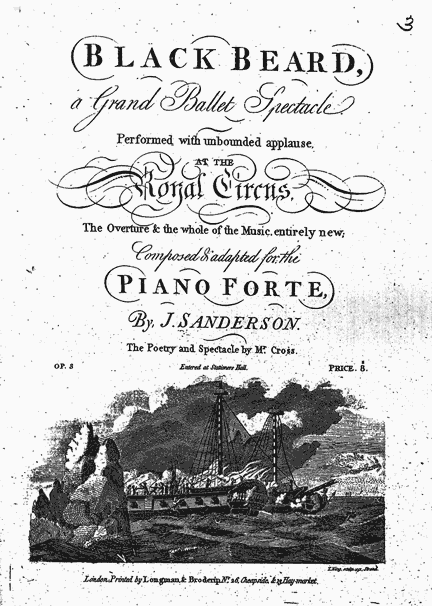
Fig. 1
The frontispiece of the published piano-vocal edition of James Sanderson’s score for Blackbeard; or, The Captive Princess ( London: Longman and Broderip, 1798).
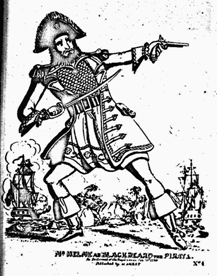 Fig. 2
Fig. 2
Mr. Helme as Blackbeard in a 1799 Royal Circus production. Reprinted in George Palliser Tuttle, “The History of the Royal Circus, Equestrian and Philharmonic Academy, 1782-1816” (PhD diss., Tufts University, 1972). Helme was the second actor to play Blackbeard; in 1799 he replaced Mr. Crossman, an equestrian specialist who probably did not sing (unlike Helme).
Toy Theatre Images : Characters and scenery cutouts from Blackbeard the Pirate; or, The Jolly Buccaneers, reprinted by Pryor Publications (Whitsable, England: 1972). The original was probably published in the 1830s by Pollocks’ Toy Theatres Ltd, of London. Also included in the booklet is the text of the play in several languages; the booklet thus contains all the materials one would need to stage Blackbeard on a toy theatre set. It should be noted that the text of the toy theatre version of Blackbeard is only loosely based upon the original version of Blackbeard as staged at the Royal Circus in 1798, but the imagery is consistent with other depictions of the costumes and sets in the original production, such as the woodcut print of Mr. Helme as Blackbeard (above).
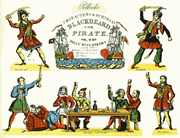 Fig. 3
Fig. 3
The front page of the booklet, which provides character cutouts: (clockwise from top left) Blackbeard in battle; Abdallah the heroic Mogul prince (a pantomime role played by Signor Angolini); Blackbeard carousing with his crew; the carousing pirates from the opening scene.

Fig. 4
The back cover of the booklet. Character cutouts: (from top left, clockwise) Ismene, the captive princess (a pantomime role played by Mrs. Wybrow); Blackbeard apprehending Ismene; Caesar, Blackbeard’s servant (a pantomime role played by Mr. d’Egville); crewmembers from the H.M.S. Pearl facing off with two pirates.
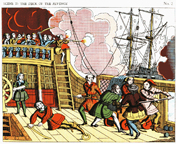 Fig. 5
Fig. 5
Backdrop of a scene in which Blackbeard’s ship, the Revenge, is battling the H.M.S. Pearl.
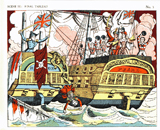 Fig. 6
Fig. 6
Backdrop of the final scene, in which Blackbeard is vanquished and thrown overboard as a British officer replaces the Skull and Crossbones with the Union Jack.
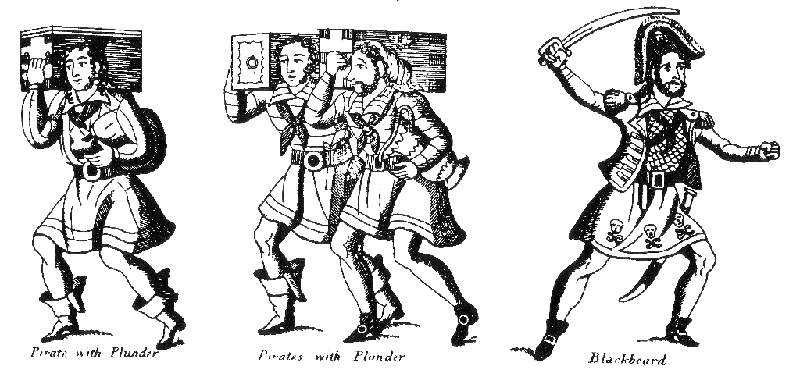 Fig. 7
Fig. 7
Black-and-white character cutouts from within the play text, depicting (from right) Blackbeard in battle and pirates carrying plunder.
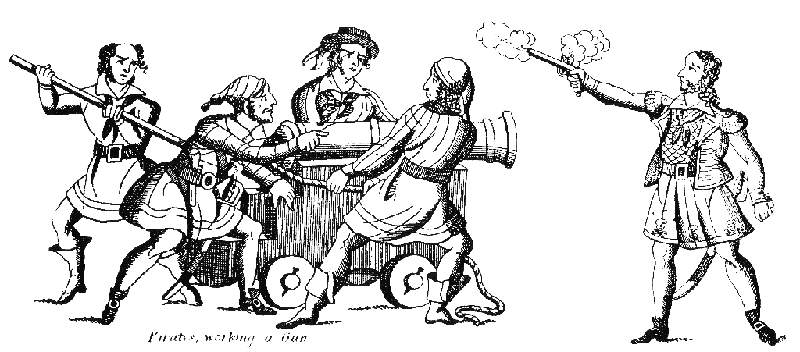 Fig. 8
Fig. 8
More black-and-white character cutouts, showing (from left) pirates working a gun, and Blackbeard in the act of using his pistol to extinguish a candle held aloft by a crewmember (his target can be found on the front page of the booklet).
OVERVIEW
The “Grand Ballet Spectacle” Blackbeard; or, The Captive Princess” premiered on April 9, 1798 at the Royal Circus Theatre, a “minor” London playhouse south of the Thames. It was an immediate hit, attracting large crowds from the north and holding the stage through the end of July, an unprecedented run at the time. Likely aiding its success were superficial similarities to Coleman’s and Kelly’s Blue-Beard, which had helped feed a vogue for pantomime-influenced Romantic musical dramas, and also parallels (many of them deliberate) between the production’s sprawling nautical narrative and recent events in the war with France. Another contributing factor seems to have been the sheer audience appeal of Blackbeard’s combinations of pantomimed action, music and elaborate historical-adventure scenarios. Commentators in later years have observed that Cross’s innovative stage aesthetic seems to have anticipated the Romantic melodramas of the nineteenth century – despite spoken dialogue being banned at the Royal Circus – and even prefigured elements of modern television and film swashbucklers.
A published synopsis from the original production:
THE Piece commences with the carousal of Black Beard and his Crew in the Pirate’s Grand Cabin, they descry a Sail bearing the Mogul's Colours, conveying the Princess Ismena and her Lover Abdallah – they are taken. Black Beard becomes enamoured of the Princess, and separates them: – They steer towards the Straits of Madagascar, where he has deposited his Riches in the Care of Orra, his Wife, to whom, on his landing, he introduces the Princess. Orra watches her with a jealous Eye, but dreading her Husband’s ferocious Disposition, with seeming Complacency receives her. In the Interim he gives Orders that Abdallah shall be dispatched – the Commands are received by William and his Sweetheart Nancy, the affectionate Female, who had followed his Fortunes in Disguise, and when taken by Black Beard, both became reluctantly Pirates. William recognizes in Abdallah, a Friend who had redeemed him from Slavery, and gratefully in return, aids his Escape – the jealous Orra seduces lsmena, under a Promise of Freedom, to a sequestered Spot, where she attempts her Murder, but is prevented by Black Beard, who plunges the Dagger, intended for the Princess, in his Wife's Heart – her Lover, wandering near the Spot, is wounded by Caesar (Black Beard's faithful Negro) in endeavouring to rescue his Mistress, who is conveyed once more for Safety on-board the Pirate. Her wounded Lover meets with Lieutenant Maynard, (Commander of the Pearl) who, being in Search of the Pirate, learns the Inlet where he has anchored, and determines to attack him – mean Time BlackBeard endeavours, by every Art, to seduce Ismena – but is interrupted by the Apparition of his murdered Wife – he views her with Horror, but has scarce Time to reflect, when he learns his Ship is about being boarded by the British Captain, he gives lsmena to the Care of Caesar, commanding him to lodge her in the Powder-Magazine, and should the Captain be victorious, set Fire to it, and blow them all up together, which he is on the Point of accomplishing, when his Hand is arrested by Abdallah. The British Captain, after an obstinate Engagement, plunges the piratical Monster into the Sea. Abdallah is restored to his faithful Ismena, and British Valour and Humanity conspicuously triumphant.
From “The Songs, Duets, Glees, Chorusses, [sic] &c. In the popular grand Spectacle of Music, Dance, and Action, called, Black Beard; or, The Captive Princess: As performed upwards of 100 nights, at the Royal Circus, last season; and Revived with new Songs, Scenery, Dresses, &c. On Wednesday, May 15, 1799,” ( London: T. Burton, 1799), 5-6.
Narrative background of the musical selections
Blackbeard (an amalgam of the historical pirates Henry Avery and Edward Teach) and his crew carouse belowdecks on their ship [1], drinking and engaging in dangerous feats of grog-fueled derring-do. They sight a ship of the Mughal (Mogul) Empire that appears ripe for plunder [2]. A battle ensues in which the pirates are ultimately victorious [3] and set sail for their pirate haven with the prize in tow. A pirate sings the praises of his ship and its bold crew [4]. Upon reaching their base, the victorious pirates are feted with exotic dances by the island’s slaves [5].
MUSICAL SELECTIONS (with notes & references to related images)
1. PIRATES’ GLEE: “WHILE THE JOLLY, JOLLY GROG’S AFLOAT”
PDF: Sheet Music for Pirate Chorus
Download Audio File of Pirate Chorus
Pirates:
While the jolly, jolly grog's afloat, fal, lal, la, fal, lal, la
We bid care push off his boat, fal, lal, la, fal, lal, la
The pirate leads a jolly, jolly life, fal, lal, la, fal, lal, la,
His arms, his friend; his ship, his wife; fal, lal, la, fal, lal, la
Boatswain solo (Verse 1):
Who has felt here what fear is? not one I'll be bound!
On a barrel of gunpowder view Grim asleep!
Put the lighted match to him---
(The lighted match is put to his nose---he yawns---sees the light, and goes to sleep again).
---His bottom is sound,
Your hand poize the bowl, my boys, we dash o'er the deep.
(All laugh and repeat)
Download Audio File of Boatswain Solo
Pirates:
While the jolly, jolly grog's afloat, &c.
Boatswain solo (Verse 2):
I'll wager these arms 'gainst your cutlass, old boy,
I snuff out the candle at five yards first fire;
Hold it Cæsar
(Cæsar holds the candle)
don't shake so,
There---zounds! I've let fly!---
(Blackbeard fires and snuffs out the candle,)
I've won---poize the bowl again, brave boys poize it higher.
(All laugh and repeat)
Pirates:
While the jolly, jolly grog's afloat, &c.
NOTE: Depictions of this scene were common in printed materials related to Blackbeard, including the front cover of the toy theatre kit for the play See Fig. 3.
2. PIRATES’ GLEE: “AN ENEMY APPEARS IN VIEW”
PDF: Sheet Music for Pirate Glee
Download Audio File of Pirate Glee
Pirates:
An enemy appears in view, fal de ral lal de ral de ral de ra
To glad our jolly Pirates crew, fal de ral lal lal de ral de ra.
See, see this way she bends her course, fal, lal lal lal de fral de ra
No matter boys tho' twice our force, fal lal de ral de ral de ra,
Our black flag hoisted, Pirate like, fal de ral lal de ral de ral de ra
The great Mogul must sink or strike, fal de ral lal lal de ral de lal de ral de ra.
NOTE: The first two pieces take the form of a glee, a type of a capella or accompanied choral piece very popular with the middle-class singing societies of the time, which were heavily male-dominated.
3. THE CELEBRATED BATTLE PIECE
PDF: Sheet Music for Battle Piece
Download Audio File of Battle Piece
(n.b.: this song is a "Dialogue Catch")
Pirates:
Stand to your guns, our cannons thunder,
Soon shall strike the foe with wonder,
Fire!---fire away!
(A Sailor comes from above.)
Sailor:
We've rak'd em on the larboard quarter,
A shot, my hearts, 'tween wind and water---
She strikes---she strikes, huzza!
(Others come from above deck)
Pirates:
Full of riches, brave messmates, we take her in tow,
Under hatches her crew will be stow'd soon below.
A Princess! our brave Captain's prize!
(Another Sailor rushes down with the Mogul's colours)
Sailor:
The Mogul's vaunting colours are torn to a rag,
Triumphant above flies the Pirates black flag!
Which the World's daring effort defies!
Boatswain solo:
Now bout Ship, put the rudder boys,
Spring up the sportive gale!
To harbour, girls, and boozing boys,
We merrily set sail!---
With fol de rol, &c.
Pirates:
Now bout ship, &c.
NOTE: Musical narrations of battles were a popular sub-genre of the nascent Romantic era; Beethoven even wrote a short “Battle Symphony” that called for live cannon. In England, Franz Kotzwara’s piano piece The Battle of Prague had been wildly popular ever since its first publication in 1788. Cross and Sanderson expanded the genre considerably, however, by introducing a sung component and combining the music with an actual enactment of the battle on stage.
Most printed materials derived from Blackbeard choose to depict the final confrontation between the pirates and the Royal Navy, rather than the capture of the Mogul flagship by the pirates. These scenarios are fairly interchangeable, however. See the frontispiece of the published score [see Fig. 1] and also the second scene from the toy theatre booklet [see Fig. 5] for examples.
4. “IN THE GOOD SHIP REVENGE”
PDF: Sheet Music for In the Good Ship Revenge
Download Audio File of In the Good Ship Revenge
Boatswain solo:
In the good ship Revenge how we've spank'd through the Ocean,
She's flush to our purpose, you ne'er saw the like;
Balls and bullets whiz by, but ne'er cause an emotion,
Because, 'till we're bowl'd down, we never will strike.
Thus success and seaman's cheer glads the jolly Buccaneer.
Fond of change, in all weathers and climates we're roving,
Now a sort of hard tussle, and now a soft booze;
With the girls and a fiddle, sometimes kind and loving,
See pop'd off a messmate, and step in his shoes.
Still success and seaman's cheer glads the jolly Buccaneer.
Well stor'd now with plunder, at nine knots we're steering,
To where copper fair ones will greet us on shore;
There we'll laugh, quaff, and sing, and with kissing and swearing,
Our cargo see out, then to sea boys for more.
Thus success and seaman's cheer glads the jolly Buccaneer.
5. SECOND DANCE OF SLAVES
PDF: Sheet Music for Second Dance of the Slaves
Download Audio File of Second Dance of the Slaves
NOTE: This dance may call to mind the Janissary-inspired exoticisms of Mozart’s famous “Alla Turca” rondo from the Piano Sonata No. 11, K. 331, composed around 1783.

 Fig. 2
Fig. 2  Fig. 3
Fig. 3 
 Fig. 5
Fig. 5  Fig. 6
Fig. 6  Fig. 7
Fig. 7  Fig. 8
Fig. 8